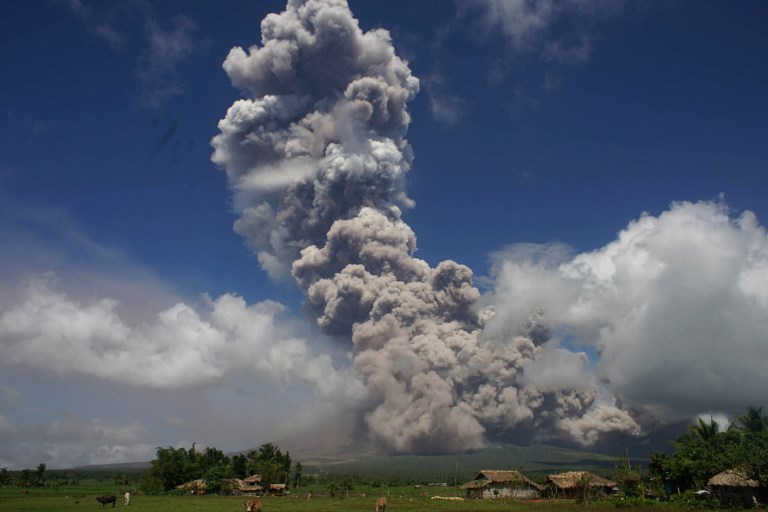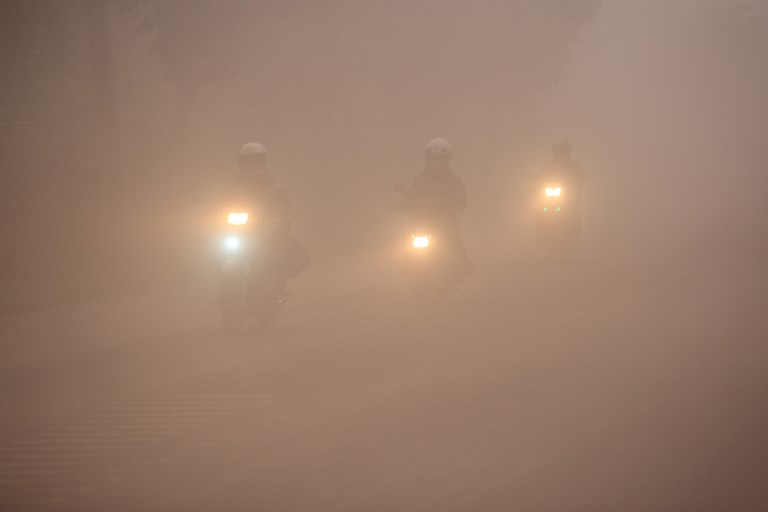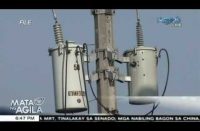
The giant mushroom-shaped cloud shot up from the Philippines’ most active volcano on January 22, witnesses and authorities said, darkening the skies and raining ash on communities where tens of thousands have fled an impending eruption. / AFP PHOTO / –
(Eagle News) — More families near Mayon Volcano are being facilitated for evacuation after the Philippine Institute of Volcanology and Seismology raised the alert level 4 warning on the volcano, meaning “hazardous eruption is imminent.”
Some 7,000 to 8,000 families are targeted for evacuation after the Phivolcs warning that Monday’s latest explosions which sent ash columns several kilometers up the volcano, would endanger those living up to eight kilometers from Mayon’s radius.
The Civil Aviation Authority of the Philippines (CAAP) said it shut down Legazpi airport until further notice, disrupting several domestic flights, while warning off other aircraft from the region. This was after the Phivolcs warning that ash from Mayon could be “hazardous to aircraft.”
A giant mushroom-shaped cloud shot up from the Philippines’ most active volcano on Monday, turning day into night as it rained ash on communities where tens of thousands have fled after warnings of an impending eruption.
The ash column rose several kilometers above the volcano, blotting out the sun in a largely agricultural region some 330 kilometers (205 miles) southeast of Manila.
At 1 p.m., Monday, January 22, Phivolcs issued its advisory: “This serves as a notice for the raising of Mayon Volcano’s status from Alert Level 3 (increased tendency to hazardous eruption) to Alert Level 4 (hazardous eruption imminent).”
“Mayon Volcano in Albay Province has been exhibiting increased seismic unrest, lava fountaining and summit explosions,” it said.
“In view thereof, DOST-PHIVOLCS is raising the Alert Level of Mayon Volcano from Alert 3 (increased tendency to hazardous eruption) to Alert Level 4 (hazardous eruption imminent). Because of this, the Danger Zone is extended to 8 kilometers radius from the summit vent. The public is strongly advised to be vigilant and desist from entering this danger zone. Civil aviation authorities must also advise pilots to avoid flying close to the volcano’s summit as ash from eruptions can be hazardous to aircraft. DOST-PHIVOLCS maintains close monitoring of Mayon Volcano and any new development will be communicated to all concerned stakeholders.”
The National Disaster Risk Reduction and Management Council, along with the local government of Albay, is facilitating the evacuation of more affected residents in the area especially now that Phivolcs has extended the previous six kilometer danger zone to eight kilometers.
NDRRMC spokesperson Marasigan said that they need to evacuate 7,000 to 8,000 additional families.
This will add to the previous total of 6,498 families or 24,611 people who are now inside 27 evacuation centers, and the 734 families or 3,119 people who are currently staying with their relatives.
-Appeal for more face masks, food-
The Albay provincial government is also appealing for more face masks and food for the affected Albay residents as the threat of continuous ashfall from Mayon volcano became a reality.
Albay Governor Al Francis Bichara said their stock of face masks has been depleted, and they feared that with more evacuees coming in, even their supply of food would not be enough.
Phivolcs said Mayon volcano could blow up within days after two weeks of activity.

A giant mushroom-shaped cloud shot up from the Philippines’ most active volcano on January 22, witnesses and officials said, darkening the skies and raining ash on surrounding communities where tens of thousands have fled an impending eruption. / AFP PHOTO / CHARISM SAYAT
Fine ash and sand fell on Legazpi, a city of about 200,000 people, and nearby areas after the midday explosion turned the area into virtual nighttime, forcing motorists to switch on their lights and use windscreen wipers, an AFP video stringer said.
“I had to stop because my helmet had filled up with ash,” local housewife Girlie Panesa, 39, told AFP as e parked her motorcycle by the roadside in the nearby town of Ligao.
She asked bystanders for water to wash the cement-grey ash off her visor, saying she plans to ride home despite the hazardous conditions because her teenage daughter was alone in their house.
-Explosions to continue-
“We expect the explosions to continue,” Philippine Institute of Volcanology and Seismology director Renato Solidum told a news conference in Manila.
“There is a possibility of a dangerous eruption, the start of which we are already witnessing,” Solidum added.
He advised local officials to evacuate more areas around the crater, expanding the danger zone from six kilometers to eight kilometers.
He also warned aircraft to steer clear of the area due to the danger of jet engines sucking in ash which could gum up turbines, potentially causing a catastrophic crash.
More than 40,000 people had fled in the past week, the civil defense office in Manila said Monday.
Solidum said superheated volcanic rocks and ash rolled down the volcano’s flanks while the ash column was shooting up, threatening surrounding communities.
Mayon, a near-perfect cone, rises 2,460 metres (8,070 feet) and is considered the most volatile of the country’s 22 active volcanoes.
There have been 51 previous eruptions in recorded history, the last one in 2014. In 1814 it buried the town of Cagsawa, killing more than 1,000 people.
The Philippines is part of the Pacific “Ring of Fire” of islands that were formed by volcanic activity.
The most powerful explosion in recent years was the 1991 eruption of Mount Pinatubo, about 100 kilometers northwest of Manila, which killed more than 800 people.
(with a report from Agence France Presse)







